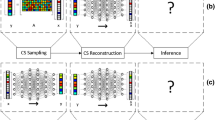Abstract
This paper proposes a novel time of arrival (TOA) estimation method which achieves the sub-chip resolution. In this proposed method, the sparsity of the wireless channel is utilized to adopt the emerging technique of compressive sensing (CS) for accurate TOA estimation. The received signal is first processed to make the sensing matrix satisfy the restrict isometry property requirement of CS framework; then the signal samples with the amplified noise are removed to improve the recovery performance; finally, the dantzig selector method is used to recover the sparse channel for TOA estimation.






Similar content being viewed by others
Notes
\(\lceil x \rceil \) is the ceil of \(x\).
The total average power of the channel is normalized to be unity.
References
Park, J., Charrow, B., Curtis, D., Battat, J., Minkov, E., Hicks, J., Teller, S., & Ledlie, J. (2010). Growing an organic indoor location system. In Proceedings of the 8th international conference on Mobile systems, applications, and services, pp. 271–284, ACM.
Misra, P., & Enge, P. (2006). Global positioning system: Signals, measurements, and performance. Lincoln: Ganga-Jamuna Press.
Zhou, Y., Guan, Y. L., & Law, C. L. (2010). Modified phase-only correlator with kurtosis-based amplified-noise suppression. IEEE Transactions on Wireless Communications, 9, 3341–3345.
Xu, C., & Law, C. (2008). Delay-dependent threshold selection for UWB TOA estimation. IEEE Communications Letters, 12, 380–382.
Lagunas, E., & Najar, M. (2011). Sparse channel estimation based on compressed sensing for ultra wideband systems. In 2011 IEEE international conference on ultra-wideband (ICUWB), pp. 365–369, 14–16 September 2011.
Le, T. N., Kim, J., & Shin, Y. (2010). An improved ToA estimation in compressed sensing-based UWB systems. In 2010 IEEE international conference on communication systems (ICCS), pp. 249–253, 17–19, November 2010
Wang, P., Ruan, H., & Fan, F. (2012). A method of indoor multi-path IR-UWB localization based on Bayesian compressed sensing. In 2012 IEEE 11th international conference on signal processing (ICSP), vol. 1, pp. 56–59, 21–25 October 2012.
Bian, Y., & Last, D. (1997). Eigen-decomposition techniques for loran-c skywave estimation. IEEE Transactions on Aerospace and Electronic Systems, 33, 117–125.
Li, X., & Pahlavan, K. (2004). Super-resolution toa estimation with diversity for indoor geolocation. IEEE Transactions on Wireless Communications, 3, 224–234.
Saarnisaari, H. (1997). TLS-ESPRIT in a time delay estimation. In Proceedings of 47th vehicular technology conference, vol. 3, pp. 1619–1623.
Vuokko, L., Kolmonen, V. M., Salo, J., & Vainikainen, P. (2007). Measurement of large-scale cluster power characteristics for geometric channel models. IEEE Transactions on Antennas and Propagation, 55, 3361–3365.
Bajwa, W., Haupt, J., Raz, G., & Nowak, R. (2008). Compressed channel sensing. In Proceedings of 42nd annual conference on information sciences and systems, pp. 5–10.
Candes, E., Romberg, J., & Tao, T. (2006). Robust uncertainty principles: exact signal reconstruction from highly incomplete frequency information. IEEE Transactions on Information Theory, 52, 489–509.
Donoho, D. (2006). Compressed sensing. IEEE Transactions on Information Theory, 52, 1289–1306.
Tropp, J., & Gilbert, A. (2007). Signal recovery from random measurements via orthogonal matching pursuit. IEEE Transactions on Information Theory, 53, 4655–4666.
Candes, E., Romberg, J., & Tao, T. (2006). Stable signal recovery from incomplete and inaccurate measurements. Communications on Pure and Applied Mathematics, 59, 1207–1223.
Tibshirani, R. (1996). Regression shrinkage and selection via the lasso. Journal of the Royal Statistical Society, Series B, 58, 267–288.
Candes, E., & Tao, T. (2007). The dantzig selector: Statistical estimation when p is much larger than n. The Annals of Statistics, 35(6), 2313–2551.
Ji, S., Xue, Y., & Carin, L. (2008). Bayesian compressive sensing. IEEE Transactions on Signal Processing, 56(6), 2346–2356.
Rudelson, M., & Vershynin, R. (2006). Sparse reconstruction by convex relaxation: Fourier and gaussian measurements. In 40th annual conference on information sciences and systems, pp. 207–212, March 2006.
Candes, E., & Tao, T. (2005). Decoding by linear programming. IEEE Transactions on Information Theory, 51, 4203–4215.
Acknowledgments
This work was supported by the National Natural Science Foundation of China (Grant: 61101093, 61101090) and Fundamental Research Funds for the Central Universities (ZYGX2013J113).
Author information
Authors and Affiliations
Corresponding author
Rights and permissions
About this article
Cite this article
Xiong, W., Liu, C., Hu, S. et al. High Resolution TOA Estimation Based on Compressed Sensing. Wireless Pers Commun 84, 2709–2722 (2015). https://doi.org/10.1007/s11277-015-2762-y
Published:
Issue Date:
DOI: https://doi.org/10.1007/s11277-015-2762-y




